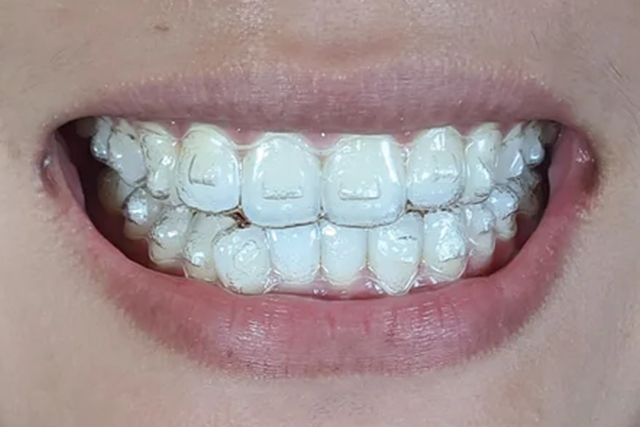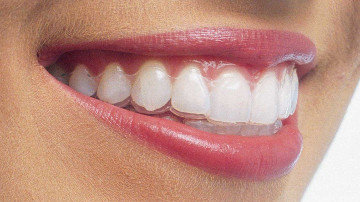Keeping Oral Health While Using Invisalign: Tips for a Smooth Experience
Keeping Oral Health While Using Invisalign: Tips for a Smooth Experience
Blog Article
Invisalign vs. Conventional Dental braces: Which Alternative Is Right for You?
When considering orthodontic therapy, the option between Invisalign and typical braces provides several important aspects that merit mindful analysis. Invisalign uses a discreet alternative with detachable aligners, while traditional braces provide a more noticeable yet efficient remedy for extreme imbalance.
Summary of Therapy Options

In comparison, typical braces contain metal brackets and cords that are bonded to the teeth. This method uses continual pressure over time to attain alignment. While reliable for complicated orthodontic concerns, typical dental braces need routine visits for changes and can present challenges in preserving oral hygiene as a result of the difficulty of cleaning around brackets and cords.
Both choices have their advantages, and the selection often depends upon specific dental conditions, way of living preferences, and patient conformity. Inevitably, speaking with an orthodontic professional is vital for establishing the most suitable treatment plan tailored to private demands. Understanding the nuances of each alternative can substantially affect the total success of orthodontic therapy.
Aesthetic Considerations
A substantial aspect influencing the option in between Invisalign and typical braces is the visual allure each treatment supplies. Invisalign aligners are crafted from clear plastic, making them virtually unnoticeable when put on. This discreet look is particularly appealing to teenagers and grownups that might really feel awkward regarding their orthodontic treatment. The capacity to maintain an all-natural smile throughout the positioning procedure can substantially enhance the individual's self-confidence in expert and social setups.
On the other hand, traditional dental braces include metal brackets and cords, which can be extra recognizable. While improvements in orthodontic technology have actually caused the advancement of smaller brackets and tinted elastics, standard dental braces still maintain an even more conspicuous account. For some people, the exposure of dental braces may deter them from looking for essential therapy.
Inevitably, the option in between Invisalign and typical dental braces may rest on individual choices concerning aesthetic appeals. People who focus on discretion frequently lean towards Invisalign, while those who are less concerned about presence might go with typical dental braces. Recognizing the visual ramifications of each choice is essential for making an educated decision that straightens with one's way of living and choices.
Comfort and Convenience

In regards to benefit, Invisalign aligners are detachable, enabling clients to appreciate their preferred foods without limitation and preserve optimum dental hygiene. Brushing and flossing are simplified, as the aligners can be obtained throughout these browse around here regimens, whereas traditional dental braces need mindful navigating around wires and braces.
Additionally, Invisalign's modern system permits less orthodontic check outs. People normally obtain numerous sets of aligners simultaneously, which can streamline the therapy process and minimize time invested in the orthodontist's chair. On the other hand, traditional dental braces necessitate normal changes, making them much less hassle-free for those with busy schedules. Invisalign. Generally, the convenience and benefit of Invisalign make it an attractive selection for numerous individuals looking for orthodontic therapy.
Therapy Period and Performance
While both Invisalign and conventional braces are effective in correcting oral misalignments, the period of treatment can differ dramatically in between the two alternatives. Commonly, Invisalign treatment can take anywhere from 12 to 18 months, depending on the complexity of the situation. The clear aligners work by slowly shifting teeth right into their wanted settings, and normal follow-ups with an orthodontist help make sure progression remains on course.
In contrast, traditional dental braces often call for a longer commitment, usually varying from 18 months to three years. This is due to their fixed nature and using cords and braces, which can over at this website be much more efficient for extreme misalignments and intricate cases (Invisalign). The therapy efficiency of traditional dental braces is well-documented, as they enable for accurate adjustments and better control over tooth motion
Eventually, the selection between Invisalign and typical dental braces may pivot on both the awaited therapy period and the certain dental concerns handy. Consulting with an orthodontist is vital, as they can supply customized referrals based on specific needs, making sure the picked approach straightens with desired end results and timeframes.
Price Contrast and Insurance Coverage Options
Expense plays a significant role in the decision-making procedure for individuals thinking about orthodontic therapy, whether opting for Invisalign or standard braces. Typically, the price of Invisalign varieties from $3,000 to $8,000, while conventional dental braces normally set you back between $2,000 and $6,000. Aspects affecting these prices consist of the complexity of the case, the period of therapy, and geographical place.
Insurance coverage can dramatically impact out-of-pocket expenditures. Numerous dental insurance policy plans offer partial insurance coverage for orthodontic treatments, but the specifics can vary extensively. It is vital for clients to evaluate their insurance coverage to identify the degree of coverage for either alternative. Normally, traditional dental braces may be extra frequently covered by insurance coverage plans contrasted to Invisalign, which some insurance providers classify as a cosmetic treatment.
In addition, a number of orthodontic methods provide flexible settlement strategies, making both therapy options much more obtainable. Patients need to inquire regarding possible financing options and price cuts for ahead of time settlements. Examining the total expense, including insurance benefits and payment strategies, is necessary for making an informed choice that aligns with both aesthetic preferences and budget plan factors to consider.

Verdict
In summary, the option in between Invisalign and site here standard dental braces depends upon several elements, consisting of visual preferences, convenience, treatment period, and price. Invisalign supplies a very discreet, removable option that helps with dental hygiene and dietary versatility, while standard dental braces may be better for complex dental issues and frequently come with a reduced cost point. Ultimately, consultation with an orthodontist is necessary to assess private conditions and establish the most appropriate treatment option for attaining optimum oral positioning.
When thinking about orthodontic treatment, the option in between Invisalign and traditional braces offers numerous crucial factors that merit careful examination.Comparing Invisalign and typical dental braces exposes unique therapy alternatives for orthodontic correction.While both Invisalign and standard dental braces are reliable in dealing with oral misalignments, the period of treatment can vary considerably in between the two alternatives.Price plays a considerable function in the decision-making procedure for people thinking about orthodontic therapy, whether choosing for Invisalign or typical braces.In summary, the choice between Invisalign and traditional dental braces pivots on several elements, consisting of aesthetic choices, comfort, therapy period, and cost.
Report this page